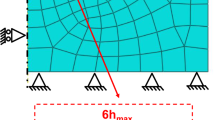Abstract
Current interest in modeling metal processing using constitutive relations is reliant on precision determination of materials testing parameters. One parameter, the strain rate sensitivity, is extensively quoted, but means to measure it precisely are generally unavailable. The best method to measure this parameter is by intermittent strain rate change tests whereby, in theory, the internal structure is kept constant during the rate change. Conventionally, it is difficult to achieve this constant structure requirement, since the load frame's elastic interaction with the specimen, as well as the specimen's elastic compliance, causes inelastic transients. These transients can be nullified by using the step ramp method and a highly responsive servohydraulic testing system. The implementation of such a method and the evaluation of the measured thermodynamic response is described.
Similar content being viewed by others
References
Hansen, N., “Microstructural and Flow Stress of Cell Forming Metals,”Viewpoint Set No. 20, Scripta Metall. et Mat.,27,947–986 (1992).
Basinski, S.J. and Basinski, Z.S., “Plastic Deformation and Work Hardening,” Dislocation Solids, ed. F.R.N. Nabaro, North-Holland, 261–362 (1979).
Saimoto, S., Saka, H., Imura, T. and Yukawa, N., “Correlation of Flow Stress and Dislocation Arrays Using HVEM,” Fifth Int. Conf. on HVEM, ed. T. Imura and H. Hashimoto, Japanese Society of Electron Microscopy, 615–618 (1977).
Tabata, T., Fujita, H., Hiraoka, M. andMiyake, S., “The Relationship between Flow Stress and Dislocation Behaviour in [III] Al Single Crystals,”Phil. Mag. A,46,801–816 (1982).
Basinski, Z.S., “Thermally Activated Glide in Face-centered Cubic Metals and Its Application to the Theory of Strain Hardening,”Phil. Mag.,4,393–432 (1959).
Haasen, P., “Plastic Deformation of Nickel Single Crystals at Low Temperatures,”Phil. Mag.,3,384–418 (1958).
Cottrell, A.H. andStokes, R.J., “Effect of Temperature on the Plastic Properties of Aluminum Crystals,”Proc. Royal Soc.,233A,17–34 (1955).
Jackson, P.J., “Comments on Dislocation Dynamics during Rate Changes,”Scripta Metall.,12,653–654 (1978).
Wielke, B. andSchoeck, G., “Reply to ‘Comments on Dislocation Dynamics during Rate Changes,’”Scripta Metall.,12,655–656 (1978).
Champion, H.G., Duesbery, M.S. andSaimoto, S., “Elimination of Machine Transient Effects during Plastic Strain Rate Changes,”Scripta Metall.,17,135–140 (1983).
Saimoto, S., “The Characterization of Materials by Precision Strain Rate Sensitivity,”J. Eng. Materials and Technology,109,230–235 (1987).
Saimoto, S., “Materials Testing and the Validation of Microplastic Modelling,” First Pacific Rim Int. Conf. on Adv. Materials and Processing, ed. C. Shi, H. Li and A. Scott, Minerals, Metals & Materials Society, 87–95 (1992).
Saimoto, S. and Basinski, Z.S., “Method and Apparatus for Measuring Thermodynamic Response,” U.S. Patent No. 4,572,001 (1986).
Kocks, U.F., Argon, A.S. and Ashby, M.F., “Thermodynamics and Kinetics of Slip”, Prog. Materials Sci., 19, ed. B. Chalmers, J.W. Christian and T.B. Massalski (1975).
Peach, M. andKoehler, J.S., “The Forces Exerted on Dislocations and the Stress Fields Produced by Them,”Phys. Rev.,80,436–439 (1950).
Hart, E.W. andGarmestani, H., “Mechanical Testing Using Direct Control of the Inelastic Strain Rate,” J. Exp. Mech.,33,1–6 (1993).
Brown, S.B. andDave, V.R., “Test Machine and Control System Interactions in the Evaluation of Rate Dependent Metal Flow,”J. Eng. Materials and Technology,115,179–186 (April1993).
Holbrook, J.H., Rohde, R.W. andSwearengen, J.C., “The Continuity of Plastic Strain Rate,”Acta Metall.,29,1099–1106 (1981).
Dunham, D.P. andGibeling, J.C., “Strain Rate Continuity in 304 Stainless Steel during Stress Rate Change Tests,”Acta Metall.,37,2651–2658 (1989).
Saimoto, S., Sang, H. andMorris, L.R., “Microplastic Bases for Constitutive Relations Found in Tensile Testing,”Acta Metall.,29,147–155 (1981).
Newbury, D.E. andJoy, D.C., “Tensile Testing of Strain-rate-sensitive Materials at Constant Imposed Strain Rate,”Scripta Metall.,4,825–830 (1970).
Upadyaya, K.R., Diak, B.J., Carlone, M. and Saimoto, S., “Manifestation of Debris Production at High Strains and Strain Rates and Its Constitutive Characterization,” Asia-Pacific Symp. on Advances in Eng. Plasticity and Its Application, Hong Kong, Dec. 15–17, ed. W.B. Lee, 485–490 (1992).
Saimoto, S., Diak, B.J. and Carlone, M., “The Evaluation of Strain Path and Strain Rate History on Strain Rate Sensitivity,” Int. Symp. on Light Materials for Transportation Systems, Pohang, Korea, ed. N.J. Kim, 937–942 (1993).
Orchard, C.E.J., “Correlation of Solute Carbon with Tempering in Cr−Mo Boiler Steels Using Strain Rate Sensitivity Measurements,”MSc thesis, Queen's University, Kingston, Ontario (1995).
Author information
Authors and Affiliations
Rights and permissions
About this article
Cite this article
Carlone, M., Saimoto, S. Precision strain rate sensitivity measurement using the step-ramp method. Experimental Mechanics 36, 360–366 (1996). https://doi.org/10.1007/BF02328579
Received:
Revised:
Issue Date:
DOI: https://doi.org/10.1007/BF02328579




